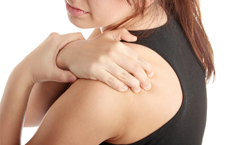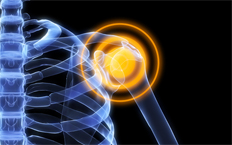 SHOULDER ARTHROSCOPY
SHOULDER ARTHROSCOPY
Arthroscopy is a minimally invasive surgical technique that involves several small incisions into which a fiber-optic device (arthroscope) and tiny surgical instruments are inserted. Orthopedic surgeons can diagnose and treat many different shoulder conditions with arthroscopy, while patients can benefit from less tissue damage, shorter recovery times, less scarring and less post-operative pain. This technique also avoids cutting any muscles or tendons in order to gain access to the affected area.
Shoulder arthroscopy is often performed to confirm a diagnosis after a physical examination and other imaging procedures have been performed. Some conditions can also be treated during the same procedure by inserting a few additional instruments into the joint area.
While arthroscopy offers many benefits over a traditional open procedure, it is not for everybody. Some conditions, especially those that are not easily visible with the arthroscopic camera, may be better suited for traditional surgery. Your doctor will decide which type of procedure is right for you.
ROTATOR CUFF REPAIR
The rotator cuff is the thick band of muscles and tendons that covers the top of the upper arm and holds in it place, providing stability and a full range of motion to the shoulder joint. It is made of four muscles and their associated tendons. These tendons can become partially or completely torn as a result of a rotator cuff tear.
A rotator cuff tear most often occurs as a result of overuse of the muscles over a long period of time. As a result, this condition is most common in patients over the age of 40. It may also occur as a result of a traumatic injury, and involve pain when lifting or lowering their arm, muscle weakness and atrophy.
Surgery may be recommended for tears that cause severe pain or that do not respond to more conservative treatments. The type of surgery performed depends on the size and location of the tear, but often involves trimming torn edges or suturing the tendon back together.
SHOULDER SEPARATION
A separated shoulder is a common injury that most often affects athletes in contact sports. This injury to the acromioclavicular (AC) joint is usually the result of a fall on an outstretched hand (FOOSH), severe lateral sheering-force, or a fall on the tip of the shoulder. It is important to note that this is not the same as a shoulder dislocation: a dislocation (subluxation) of the shoulder occurs exclusively in the glenohumeral joint.
Treatment and recovery varies greatly between the classes of shoulder separation, from a few weeks of bed rest with anti-inflammatory drugs to arthroscopic surgery requiring months of physical rehabilitation.
The Weaver-Dunn Procedure is the most frequently used surgical technique for the repair of shoulder separation. This procedure allows stability in the joint to be maintained effectively by attaching the acromial end of the coracoclavicular ligament to the displaced clavicle bone, while replacing the aforementioned ligament with alternative connective apparatus or tissue.
SHOULDER DISLOCATION
 A dislocation occurs when the humerus pops out of its socket, either partially or completely. As the body’s most mobile joint, able to move in many directions, the shoulder is most vulnerable to dislocation.
A dislocation occurs when the humerus pops out of its socket, either partially or completely. As the body’s most mobile joint, able to move in many directions, the shoulder is most vulnerable to dislocation.
Dislocation causes pain and unsteadiness in the shoulder. Other symptoms may include swelling, numbness, weakness and bruising. The majority of dislocations occur when the humerus slips forward, a condition called anterior instability. This may happen during a throwing motion. The humerus is also capable of dislocating backwards or downwards. In most cases, the dislocated shoulder can be manipulated back into place by a doctor in a process known as closed reduction.
Complications of shoulder dislocation or reduction can include a labrum or cartilage tear, a lesion on the glenoid bone after the humerus strikes it, tendon or ligament injuries, and blood vessel and nerve damage. Shoulders that have dislocated once are more likely to dislocate in the future, potentially resulting in chronic shoulder instability and weakness.
For more information on problems of the shoulder and the treatments we provide, please call the office nearest you.

